Watermelon kombucha is the perfect flavor to second ferment for summer. Made with real fruit and full of probiotic goodness, this second fermentation is one you want to have ready for a hot summer day!
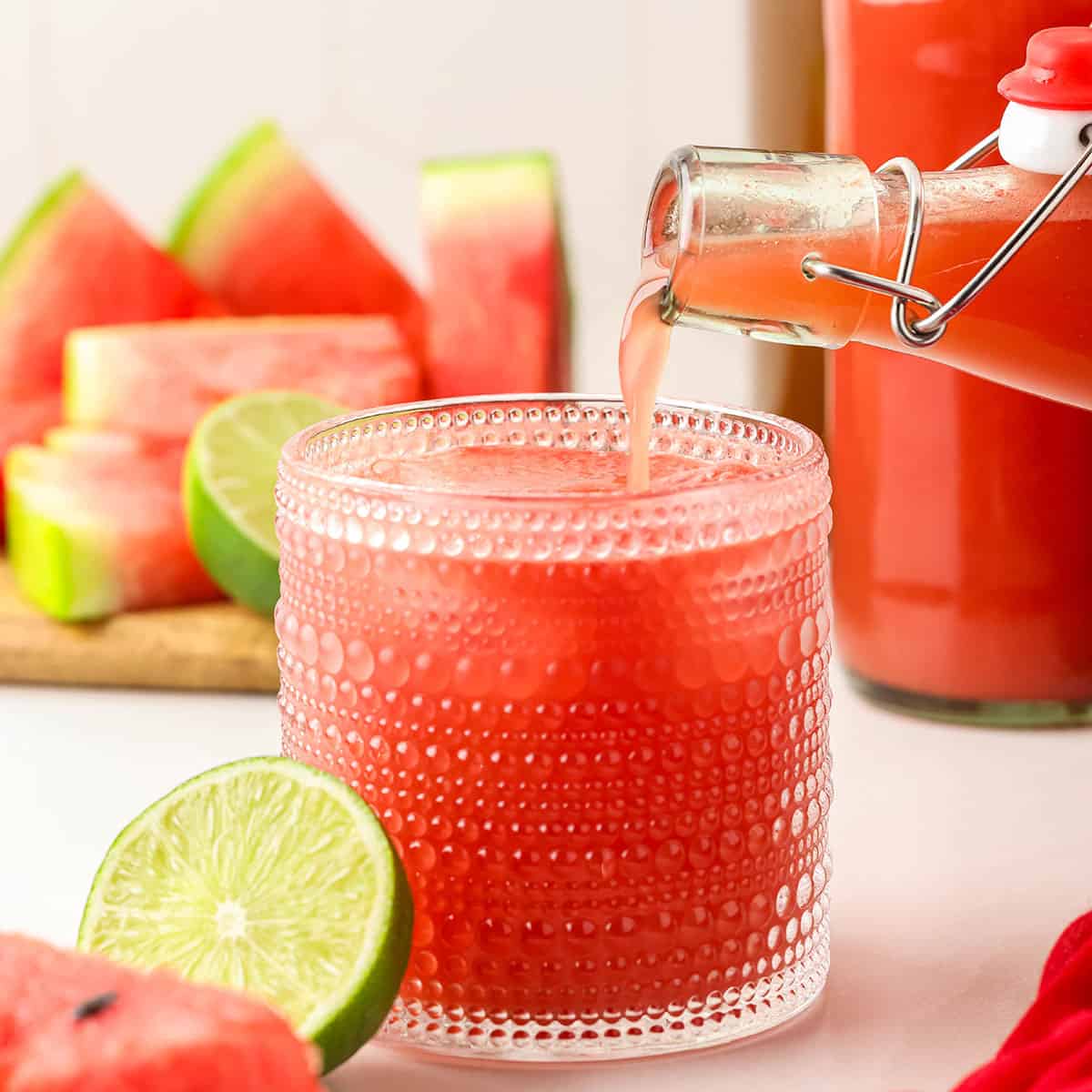
Want to save this post for later?
Second Fermentation with Fruit
Once you have a one gallon batch of kombucha made, add flavor and fizzy delight to it with a second fermentation process. It’s easy, fun, and delicious!
There are several ways to infuse flavors to kombucha, one way is to use a simple tea and sugar like rose, hibiscus, or dandelion. Or, making a simple syrup like I do in this lavender kombucha works well too.
Another great way to do it is with fruit! Some fruits have just the right amount of natural sugars to fuel the fermentation process, and just like tea infusions, they bring a whole host of other benefits to kombucha.
What’s the Deal With Sugar in Kombucha?
In most kombucha second fermentation recipes, you’ll notice that sugar is added. It seems counterintuitive to those of us pining for the health benefits of probiotics and tea!
Sugar is what fuels the fermentation process, so it is necessary on some level in order to achieve the goodness that fermented foods offer.
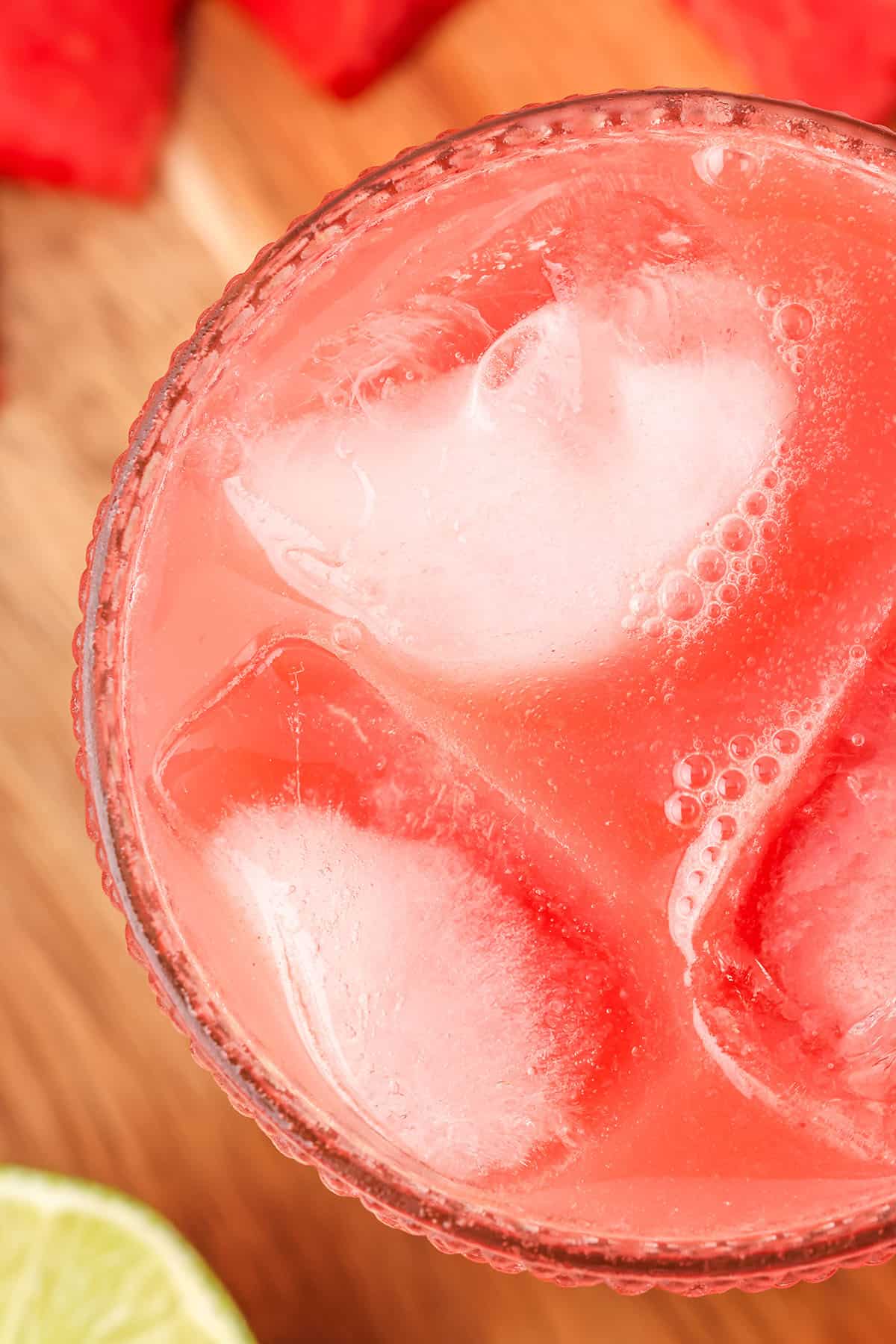
The good news is that the yeast from the originally fermented kombucha will metabolize the sugar, making a perfect host for gut healthy bacteria to thrive. And, it makes the fizz fizzy!
So if you add sugar in recipes like strawberry kombucha, or sugary fruit like watermelon in this recipe, don’t worry! The end result isn’t a sugar laden drink at all. It’s a flavorful, fizzy, sweet and tart delight.
Watermelon kombucha has tons of health benefits that can actually help reduce inflammation, not add to it like sugary sodas. It’s a great way to get a summertime chill with beneficial bacteria!
It All Starts With a SCOBY
To make watermelon kombucha with a second ferment, the first thing you need is a brewed batch of kombucha made with a SCOBY (Symbiotic Colony of Bacteria and Yeast).
If kombucha and SCOBY feel like a chicken or egg first question to you, just know that you need kombucha to make a SCOBY, but you also need a SCOBY to make a first batch of kombucha.
This isn’t super clear, I realize, but don’t worry! SCOBY magic is easy to obtain from your neighborhood hippy, or an online SCOBY dealer like Kombucha Kamp where I recommend getting the mother culture.
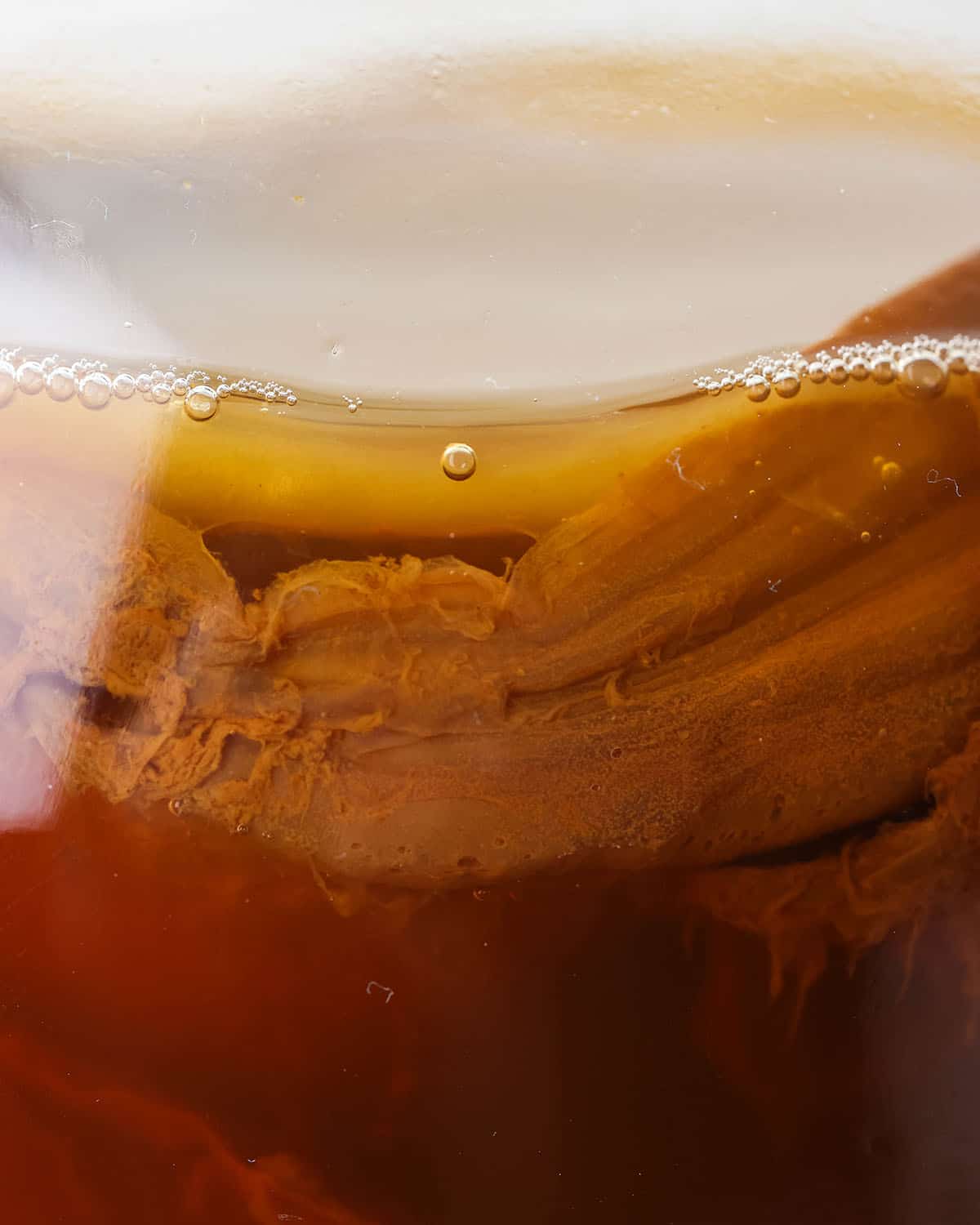
It’s also possible you have a baby SCOBY lying around in your very own kitchen if you have a previous batch of brewed kombucha. Yes, SCOBYs have babies. Wait, what?!
For all of the basics and a general love story about SCOBYs if you’re just starting out, this basic kombucha recipe is a great place to start.
I recommend using green tea kombucha as the base for watermelon kombucha. I love the way the lighter flavor and bubbly nature goes along with the summery flavor of watermelon for a sweet and sour finish.
Watermelon Kombucha Recipe
With just a few ingredients and a little fermenting time, you’ll be on your way to this naturally bubbly and refreshing summer drink! Watermelon kombucha has a delicious flavor and is a quick second ferment.
I use pureed watermelon that includes the seeds in this recipe, it has tons of vitamins and minerals and the natural sugars work beautifully to feed the ferment.
Ingredients
Watermelon: I cut the watermelon into small cubes to make the puree process easier. I blend the watermelon, seeds and all, but feel free to use a seedless watermelon, if you prefer.
Limes: Freshly juiced is best!
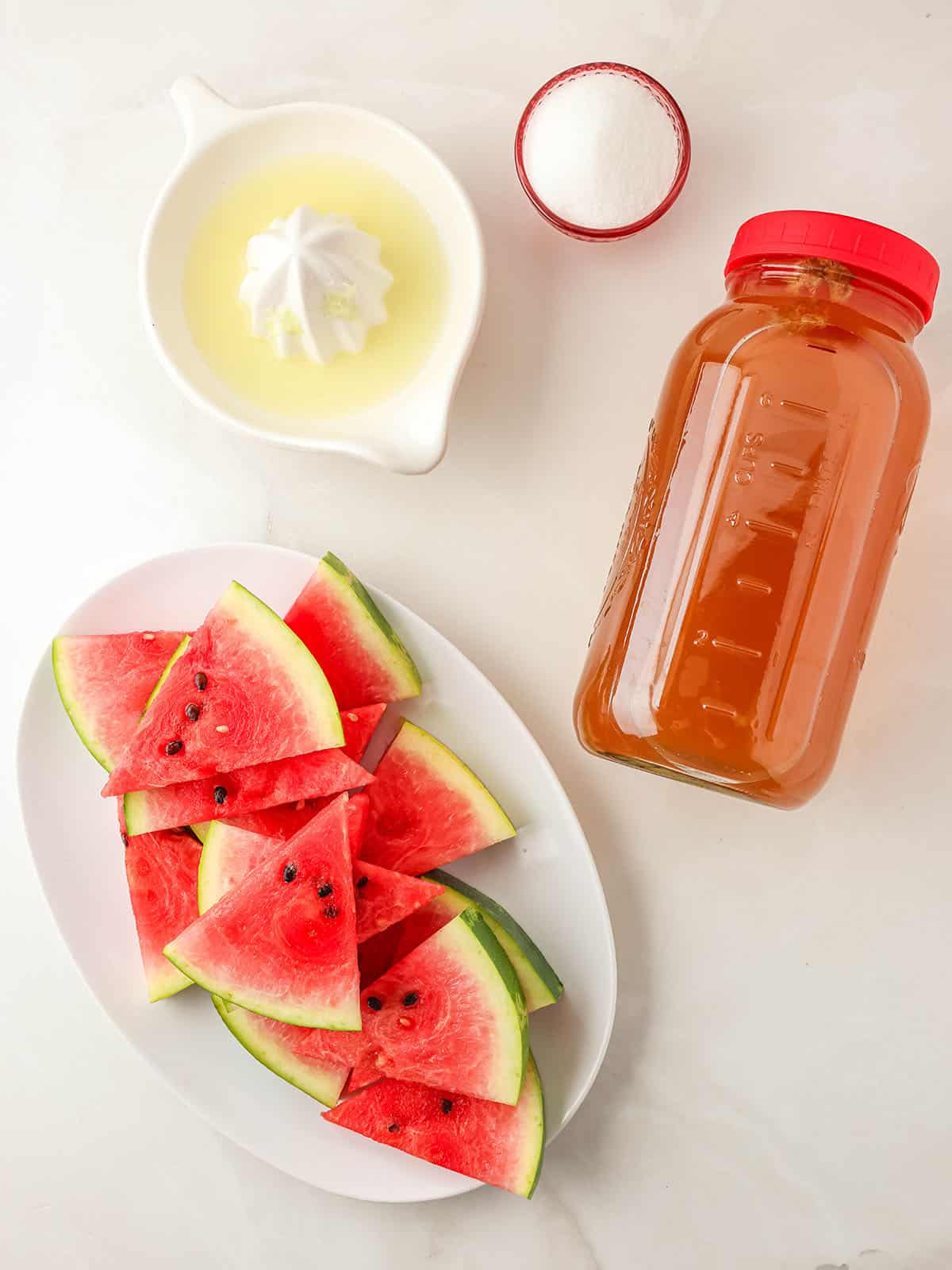
Sugar: Using cane sugar is optional in this recipe, as the watermelon should be enough to fuel the second fermentation process. It depends on personal preference for sweetness.
Fermented kombucha: I use green tea kombucha for this recipe because the flavor is lighter and pairs really well with watermelon, but black tea kombucha works too.
To Make the Watermelon Puree
Slice the watermelon into small chunks or cubes so they can easily fit into a blender or food processor.
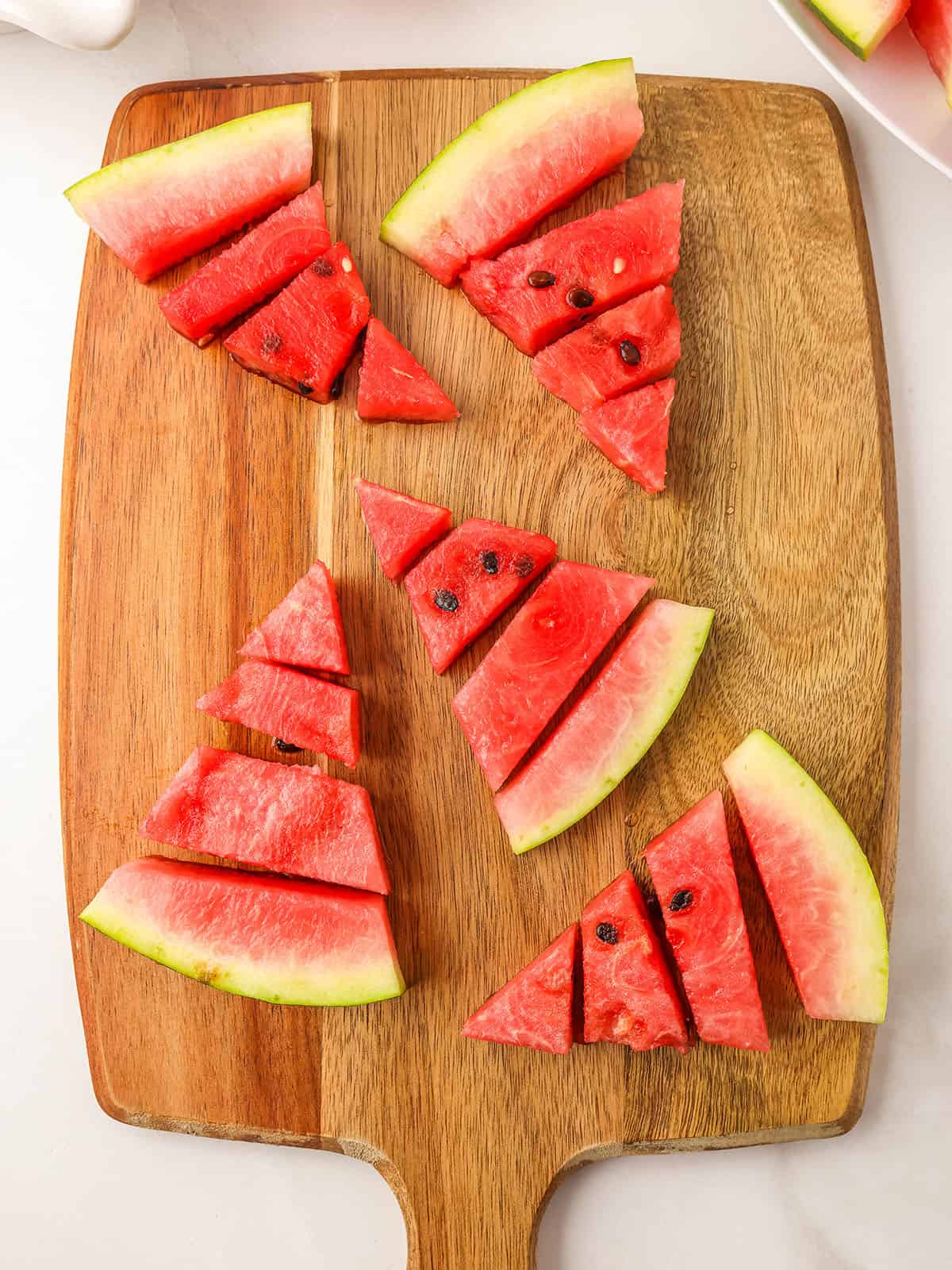
I blend the watermelon seeds in because they add to the nutritional benefits, and it’s also way easier. Feel free to de-seed if you have extra energy, or use a seedless watermelon.
Place watermelon cubes, lime juice, and sugar (if desired) into a blender. Blend on high until you have a nice, smooth watermelon mixture.
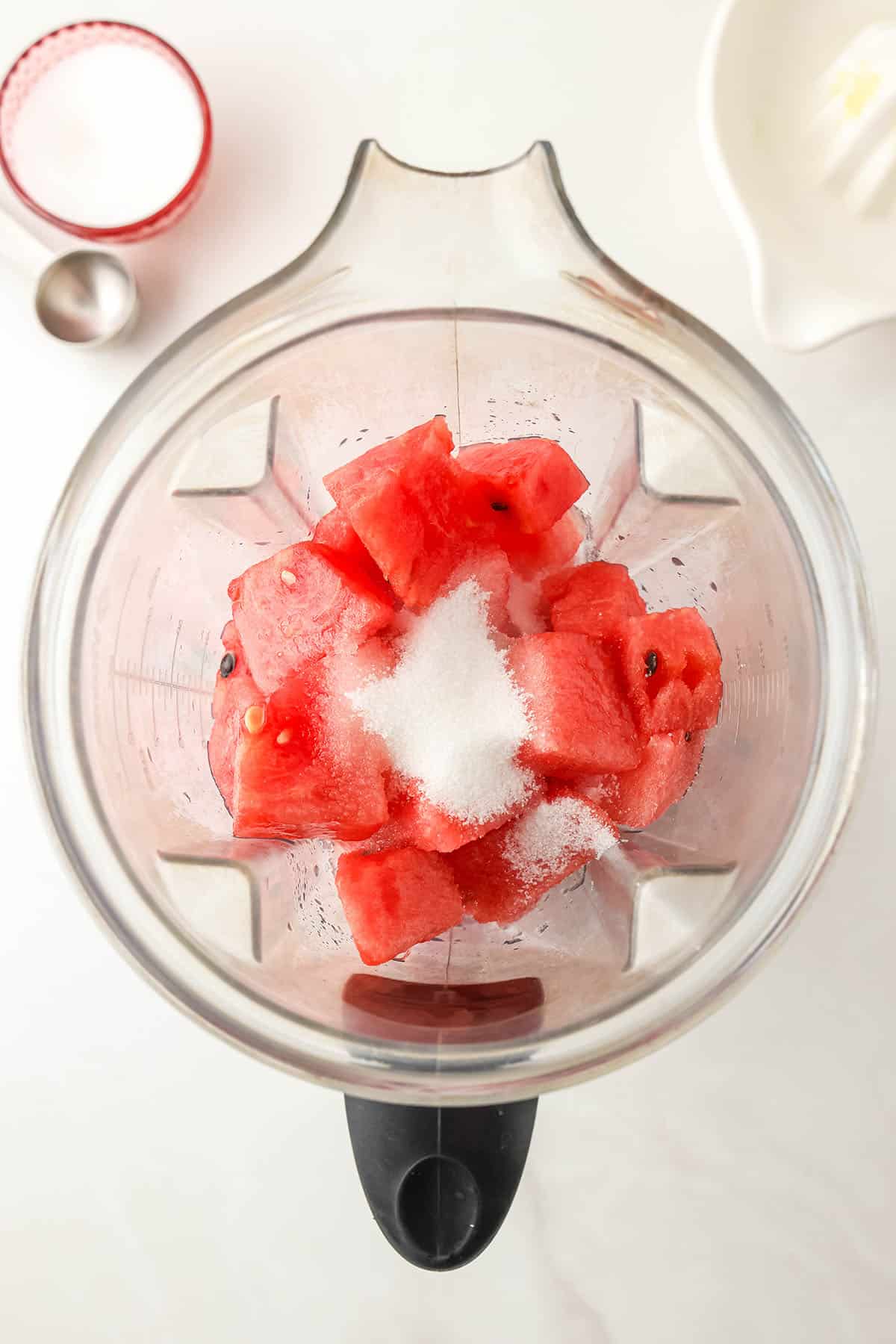
Watermelon Kombucha Second Fermentation
First, gently swirl the fermented kombucha from the first fermentation process to distribute the yeast and good bacteria before pouring it into the bottles.
Then use a funnel to pour about one cup of the fermented kombucha into each swing-top bottle, until it is about halfway full.
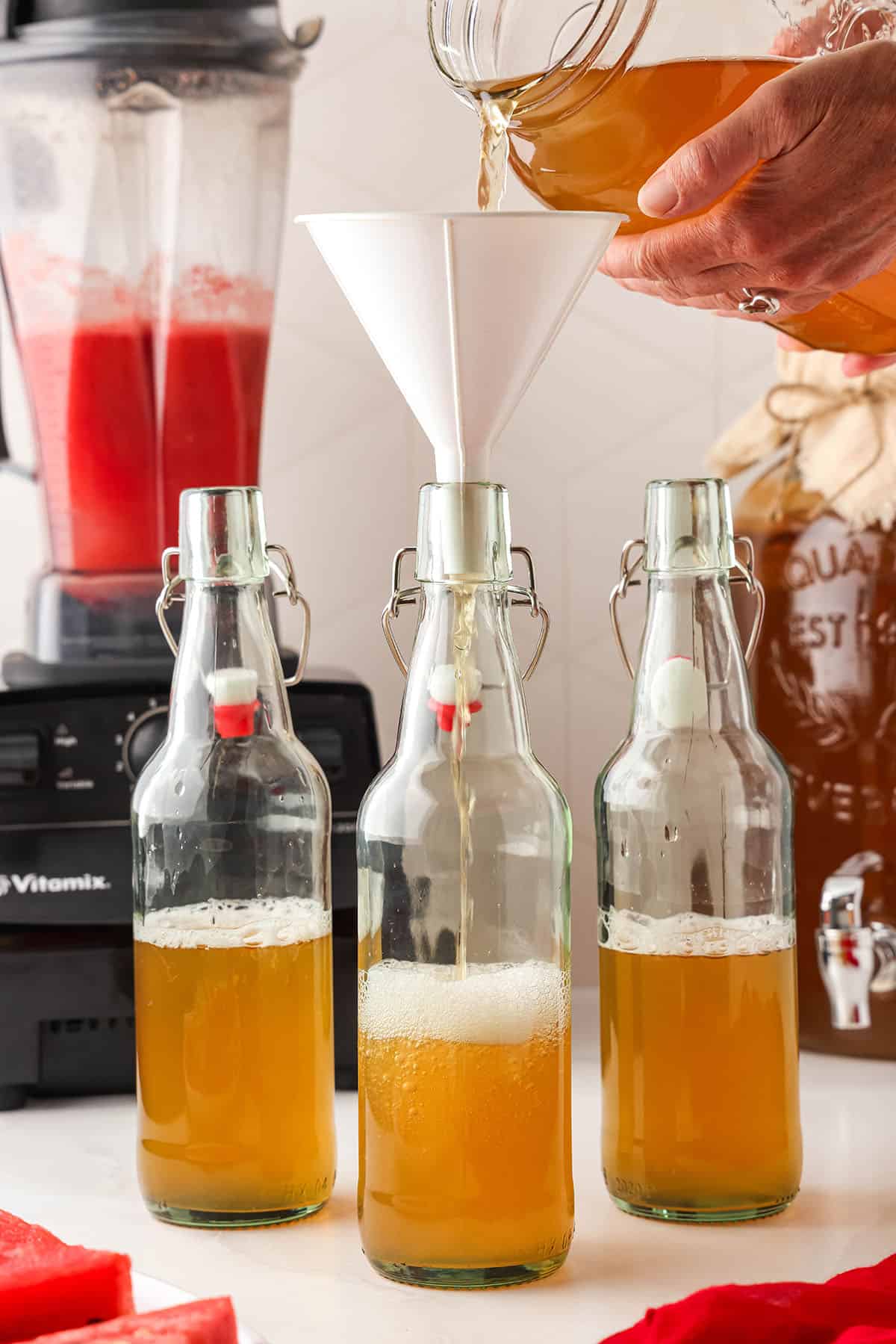
Note: If you don’t have swing-top bottles, any bottle that has a tight-fitting lid will work.
Then add the watermelon puree into each bottle, and make sure to leave about an inch of headspace at the top of the bottle.
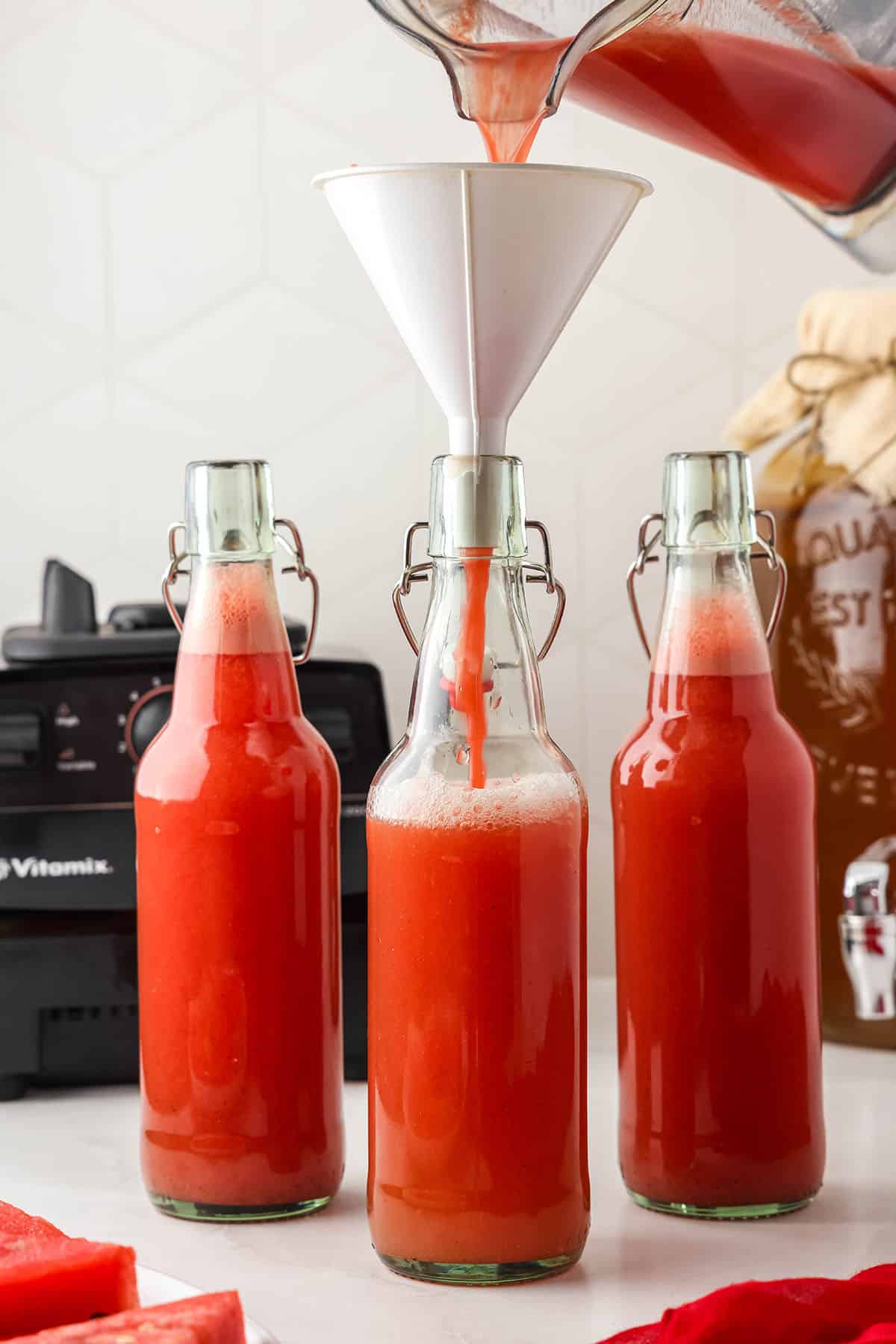
Note: Half and half is a good place to start for the ratio of kombucha to watermelon puree in the bottles, but if you want more kombucha and less watermelon puree in each bottle that will work too.
Seal the bottles tightly, and store them at room temperature. Make sure they’re in a place out of direct sunlight like a shady kitchen corner or a pantry.
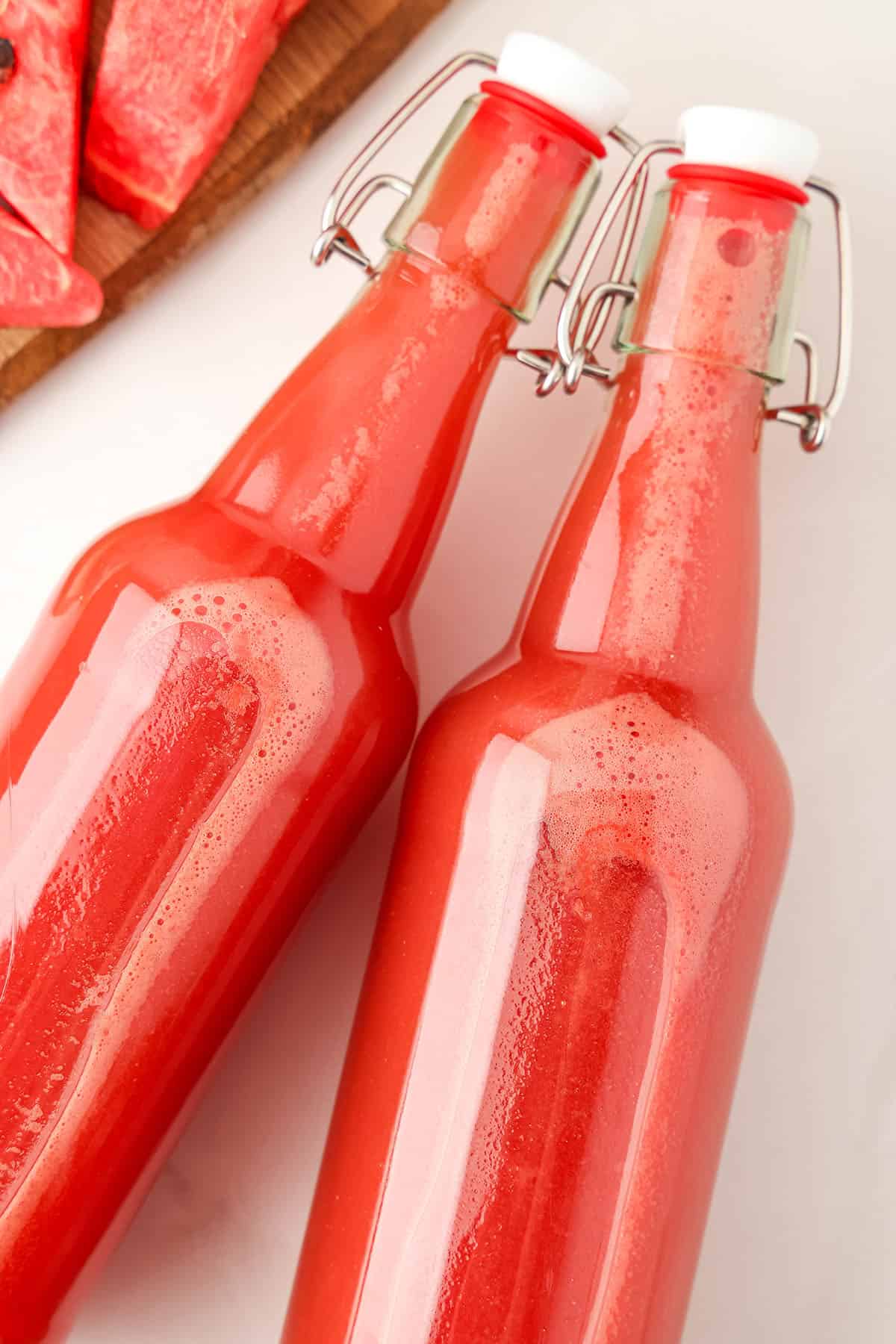
Be sure to mark the date that you bottled to keep track of how long it’s been. This will help prevent any bottle explosions due to built up pressure.
It is important to check watermelon kombucha daily for carbonation. The second fermentation process can take anywhere from 1-3 days depending on the ambient temperature (warmer temps will ferment faster).
Since we are using whole fruit, this kombucha has a tendency to complete the second fermentation process very quickly and builds a lot of carbonation!
As the fermentation process occurs, you will notice little bubbles forming at the top and the yeasts will float. Check the bottles daily and “burp” them at least once daily to release pressure.
If there is built up pressure and bubbles race to the top, then move those bottles to the refrigerator.
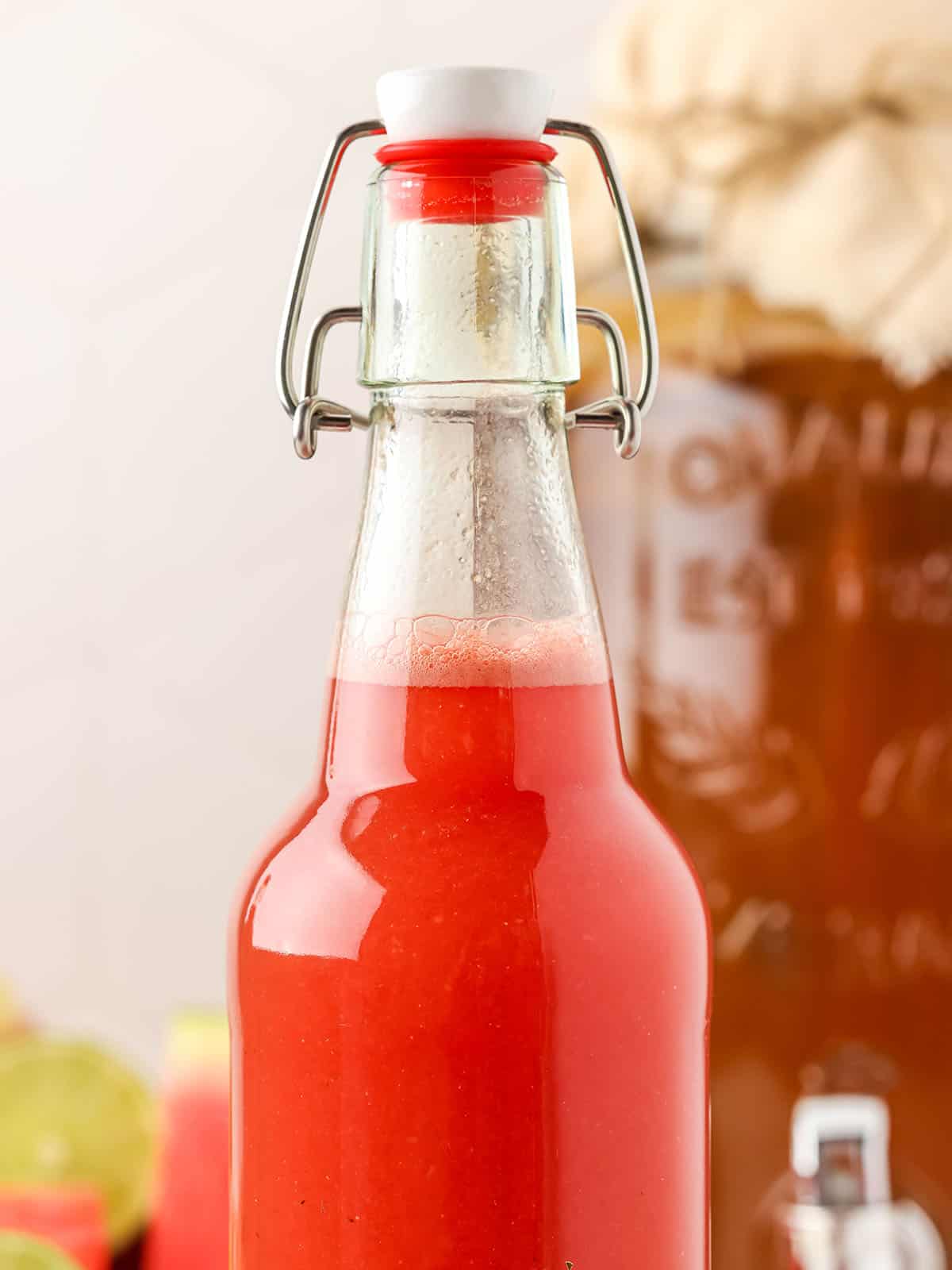
Recipe Tips
Alternately, the bottles can go right into the refrigerator for the second ferment for a slower fermentation. Take into account how warm your storage area is, since this flavor can be highly active and very bubbly.
Watermelon kombucha will naturally separate, but it will still get fizzy. To mix it back up, gently turn the bottle upside down or roll it on its side.
All that carbonation is now under pressure, so be careful with it! Open the bottles over a sink with a rag on top to keep any messes minimal.
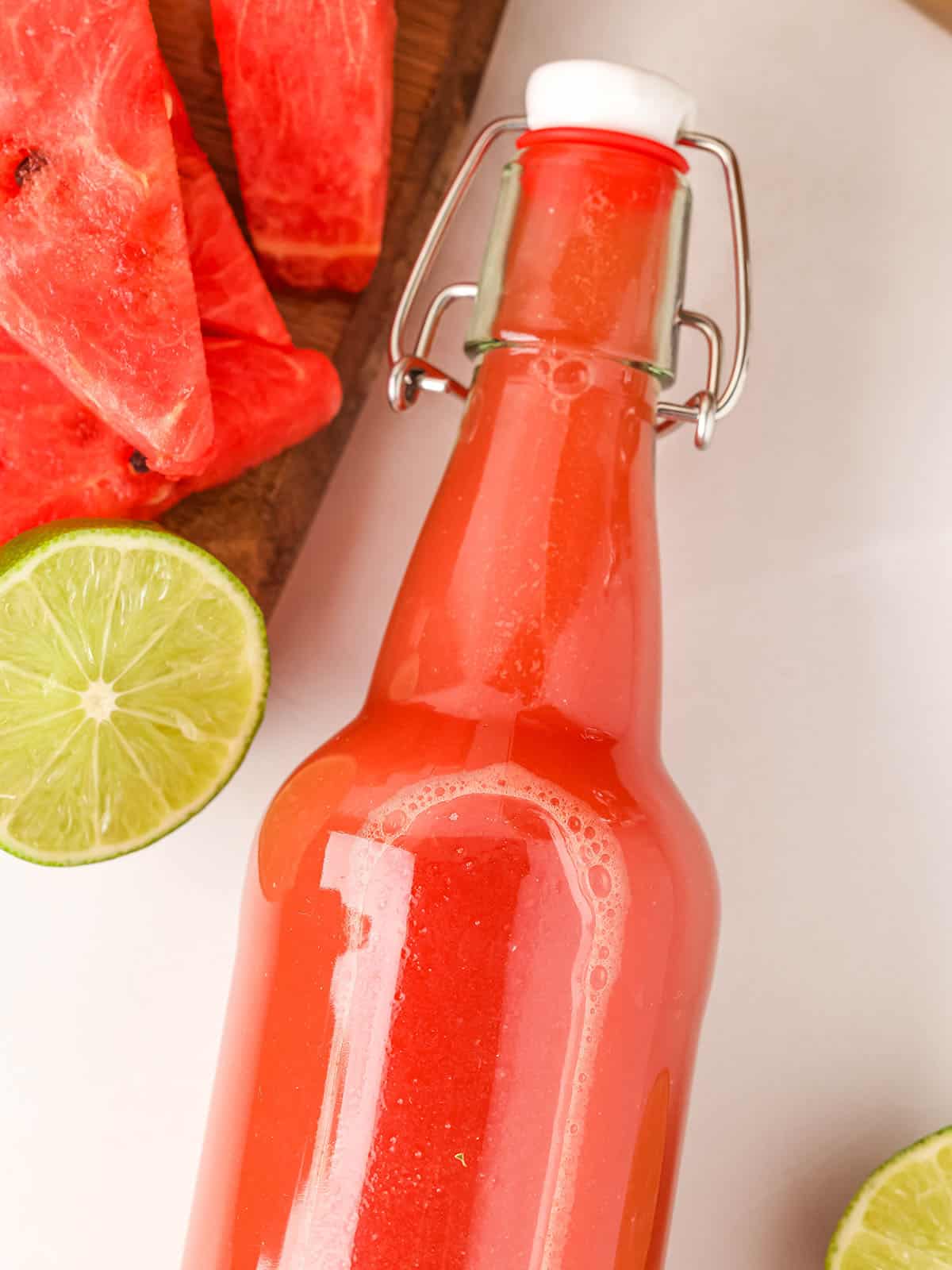
Serving Watermelon Kombucha
Chill the bottles in the refrigerator before serving, and enjoy this super summery drink on a warm afternoon!
Kombucha is a healthy refreshing switch from soda, and this watermelon flavor is a perfect drink to serve with snacks. Try it with dandelion fritters or Queen Anne’s lace fritters for a true summer snack pairing!
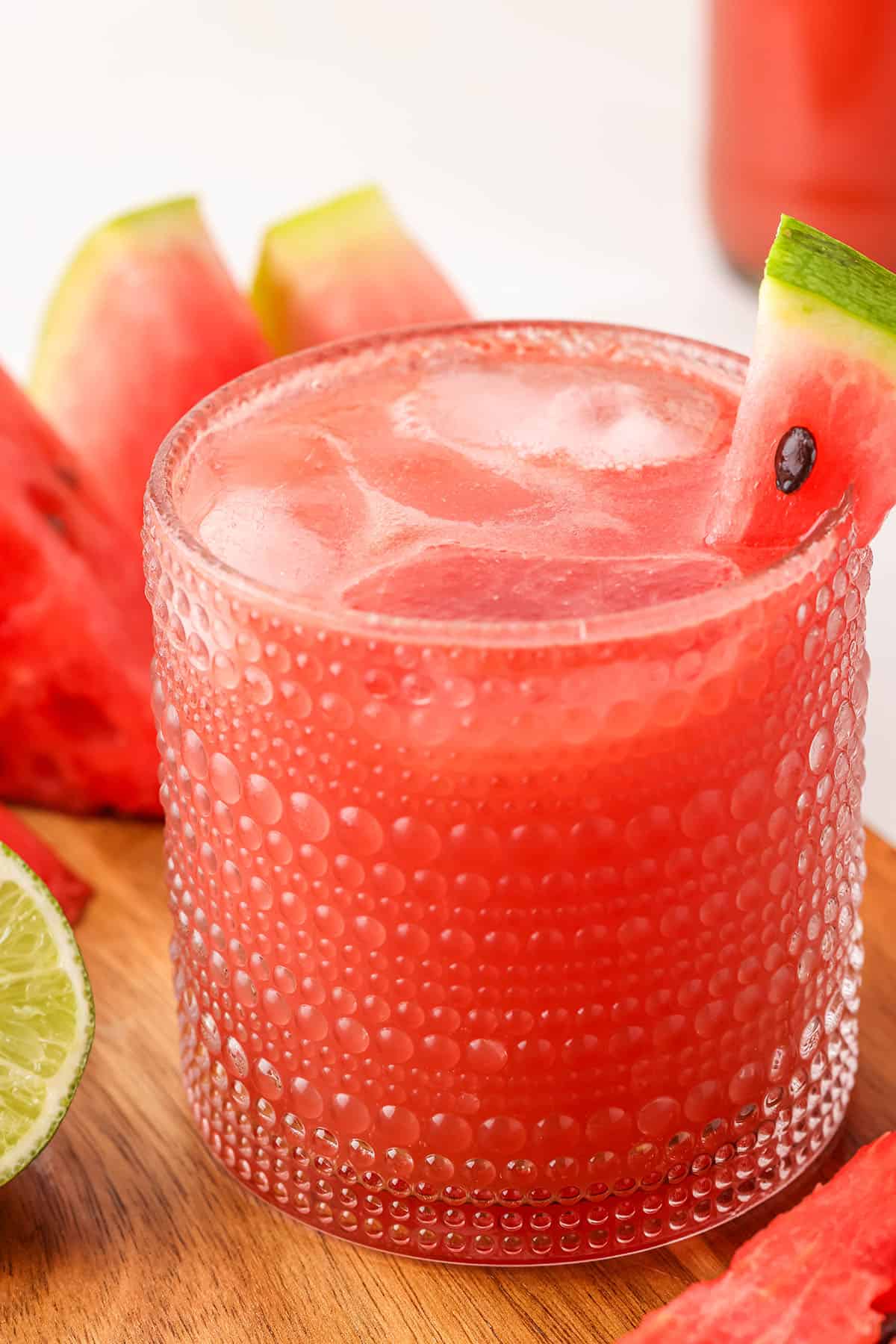
To make this kombucha into a happy hour drink, definitely try it in this gin watermelon kombucha crush. It sounds delicious!
However you sip it, this kombucha will bring you health benefits, a chill down, and a fresh summer vibe. We all need it when the heat of the season brings a slow afternoon in. Cheers!
More Fermented Drinks
- 12 Fermented Soda Recipes
- Pine Needle Soda
- Fermented Root Beer
- Ginger Kombucha
- Yarrow, Rose, & Strawberry Soda
Best Kombucha Flavors
- Blueberry Kombucha
- Dandelion Kombucha
- Ginger Kombucha
- Hibiscus Kombucha
- Lavender Kombucha
- Rose Kombucha
- Strawberry Kombucha
- Blackberry Kombucha
- Elderberry Kombucha
- Apple Ginger Kombucha
- Pumpkin Kombucha
- Cranberry Kombucha
Watermelon Kombucha Second Ferment
Equipment
Ingredients
Watermelon Puree
- 7 cups watermelon cut into small cubes
- 2 limes juiced
- 2 teaspoons sugar optional
Watermelon Kombucha
- 4 cups fermented kombucha green tea kombucha works well
- 4 cups watermelon puree
Instructions
- Place watermelon cubes, lime juice, and sugar (if desired) into a blender. Blend on high until you have a nice, smooth watermelon mixture.
- Gently swirl the fermented kombucha (from the first fermentation process) before you pour it into the bottles to evenly distribute the yeast.
- Use a funnel to pour the fermented kombucha into swing-top bottles, or any bottle that has a tight-fitting lid, to halfway full (about 1 cup per bottle).
- Add the watermelon puree to each bottle, leaving about an inch of headspace at the top of the bottle
- Seal the bottles tightly and store them at room temperature out of direct sunlight.
- As the fermentation process occurs, you will notice little bubbles forming at the top and the yeasts will float. Check the bottles daily and “burp” them at least once daily to release pressure. If there is built up pressure and bubbles race to the top, then move the bottles to the refrigerator. The 2 fermentation process can take anywhere from 1-3 days depending on the ambient temperature (warmer temps will ferment faster).
- Chill the bottles in the refrigerator before serving.
Notes
- I blend the watermelon, seeds and all, because the seeds contain nutritional benefits such as added vitamins and minerals. Feel free to use a seedless watermelon, if you prefer.
- I use green tea kombucha for this recipe because the flavor is lighter and pairs really well with watermelon, but black tea kombucha can also be used.
- It is important to check this kombucha daily for carbonation. Watermelon kombucha has a tendency to complete the second fermentation process very quickly.
- Watermelon kombucha will naturally separate, but it will still get fizzy. To mix it back up, gently turn the bottle upside down or roll it on its side to mix it back up.
- The bottles can go right into the refrigerator for the second ferment if you prefer, but it will slow down fermentation.
- Be sure to mark the date that you bottled so that you can keep track of how long it’s been to help prevent any bottle explosions due to built up pressure.

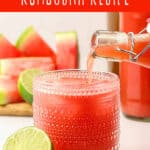

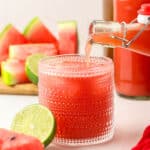

Leave a Reply